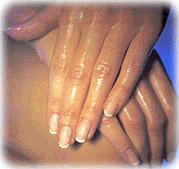
Nails Care

|
Nails Care
|
|
Maintaining healthy natural nails is not
as complicated as many may think. As with hair, nails are usually their
healthiest in their natural state, requiring a bit of nail polish for
protection and regular applications of hand cream as a moisturizer. FACT:
If you have a diet that is rich in oils you will have beautiful hair and
nails. This is because virtually any kind of oil contains vitamins that
are great for nails. Tab's
DO's & DON'T's for nail care: Do not put your hands into any kind of washing up liquid Think about a leftover bowl of a chicken casserole and what happens when you squirt one bit of detergent on that. Now consider what that's doing to the natural oils in your hands and the natural oils in the fingernails which is the only part holding the finger nails together. It's totally destructive! It's dangerous to cut the cuticles of your nails The cuticle is a natural seal where the skin bonds with the nail. If you open a cuticle up, you allow bacteria to have access straight into the blood system. The cuticle solution Cuticles should be removed with cuticle removing solution. Also, every time your hands are in the bath for a long time, rubbing the cuticle and moving it back removes the dead cells. They must be very soft to do that and be in the water for 15 minutes. Beware of fast drying nail polishes Fast drying nail polishes today have a high percentage isopropyl alcohol (IPA). This tends to make nails dry and crumble. Once the polish dries up it become brittle, flaky and begins to chip off. A nail polish that bonds really well is also the type that takes a while to dry. So it's a trade-off. Be square! People tend to point their fingernails when they're filing, which leads to filing away the sides of the nail. Because the sides is what gives the fingernail strength, pointed nails will tend to give you splits in the sides. Pointed nails break much easier. They should grow until there is at least an eighth of an inch of free edge before you start to point them. People started to wear their nails square (particularly in the USA) out of necessity because they needed the side wall of the nail to give it strength. Every thing you touch ... is an emery board. If you have the slightest snag on the ends of your nails, it will cause your nails to rip. Every time you touch something, fingernails bend. Fingernails are meant to bend but every time you do, that snag will open up more and eventually turn into a split. How do you avoid this calamity? Use a very gentle file, never a metal file. Best beauty tip in the world Use a thick hand cream, smother your hands in it, wear cotton gloves, then rubber gloves and then do the washing up. The heat will melt the cream, releasing the natural oils and in two weeks even the roughest hands will look like a baby's bum. The transformation is amazing. And it's a way to beat the household blues! It will make the fingernails grow too. The natural oils in the fingernails is what holds them together. |
Disclaimer: This information is intended as a guide only. This information is offered to you with the understanding that it not be interpreted as medical or professional advice. All medical information needs to be carefully reviewed with your health care provider.
![]()